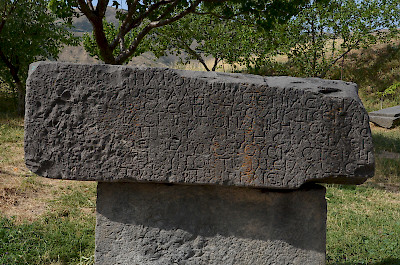Garni, Greek Inscription
Gorneae: fortress in eastern Armenia, modern Garni.

In 1945, a Greek inscription, mentioning the first Armenian king from the Arsacid dynasty, Tiridates, was found at the cemetery of Garni. The text has been taken as evidence for the date of the construction of Garni's famous temple-like monument and has been placed in front of it. However, there is no evidence that the inscription has anything to do with this monument. In fact, the text mentions the building of a fortress.note
Ἥλιος Τιριδάτης [ὁ μέγας
μεγάλης Ἀρμενίας ἀνα[χθείσης τῆς πόλε]-
ως δεσπότης αἴκτισεν αἱ [αὐτοῦ ἀδελφῇ]
βασιλίσ<σ>ᾳ τὸν ἀνίκητον κάσ[τελλον τοῦτον]
αἴτους {ἔτους}∙ αιʹ ∙ τῆς βασιλεί[ας ἐπὶ φυλακῇ]
Μεννέας ὑπὸ ἐξουσίας τειαρι[φόρου κυρίου ?]
λι<θ>ουργὸς τῷ μεγάλῳ σε[μνῷ θεῷ ․․․]
[— — —] ᾧ καὶ εὐχαριστ[εῖ]
μετὰ μα<θ>ητοῦ Μαρτυρίου.
Which can be translated as
Helios Tiridates the Great of
Greater Armenia, having as its lord subdued
this city, founded for his sister,
the queen, this impregnable fortress,
to safeguard his kingdom, in his eleventh regnal year.Obeying his tiara-wearing lord, Menneas
the stone-cutter made this for the great, venerable god,
whom he also thanks with his disciple, Martyrius.
Tiridates' eleventh regnal year would be 77 CE, counting from his second coronation by the emperor Nero, or 63 CE, counting from the moment he was made king of Armenia by his brother Vologases I, king of Parthia.